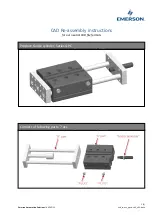
18
en
Wood and light-metal dust, hot mixtures of grinding dust
and chemical materials can self-ignite under unfavourable
conditions or cause an explosion. Avoid sparking in the
direction of the dust collector as well as overheating of
the power tool and the materials being sanded, empty the
dust collector/container in time, observe the material
manufacturer’s working instructions, as well as the rele-
vant regulations in your country for the materials being
worked.
Hand/arm vibrations
The vibration emission level given in this information
sheet has been measured in accordance with a standard-
ised test given in EN 60745 and may be used to compare
one tool with another. It may be used for a preliminary
assessment of exposure.
The declared vibration emission level represents the
main applications of the tool. However, if the tool is used
for different applications, with different accessories or
poorly maintained, the vibration emission may differ.
This may significantly increase the exposure level over
the total working period.
An estimation of the level of exposure to vibration
should also take into account the times when the tool is
switched off or when it is running but not actually doing
the job. This may significantly reduce the exposure level
over the total working period.
Identify additional safety measures to protect the opera-
tor from the effects of vibration such as: maintain the tool
and the accessories, keep the hands warm, organisation
of work patterns.
Emission values for vibration
Operating Instructions.
Do not use accessories not specifically intended and
recommended for this power tool by FEIN.
The use of non-
original FEIN accessories can lead to overheating of the
power tool and destroy it.
Guide the power tool toward the work piece only
when switched on.
The application tool can be offset in 30° steps and fas-
tened in the most favourable working position.
Changing the tool (FMT250SL (**)) (see page 4).
Screw the clamping bolt in to the stop.
Changing the tool (FMT250QSL (**))
(see pages 5/6).
Do not switch the power tool on while the clamping
lever is open.
Otherwise there is danger of crushes
or contusions to the hand and fingers.
Do not actuate the clamping lever while the power
tool is running.
Otherwise there is danger of injury.
Do not reach into the area of the clamping jaws.
Otherwise there is danger of crushes or contusions
to the fingers.
Do not operate the power tool with with open clamp-
ing jaws and without an application tool!
This could
damage the power tool.
When the clamping jaws are open before the appli-
cation tool is inserted, pivot the clamping lever
toward the front and then back again.
The clamping
jaws are closed now. The application tool can be
inserted.
Notes on sanding.
Press the power tool with the sanding sheet briefly and
firmly against a flat surface and briefly switch the power
tool on. This provides for good adhesion and prevents
premature wear.
When only one tip or corner of the sanding sheet is
worn, it can be removed again and reattached turned by
120°.
Work with the entire surface of the sanding plate, not
only with the edge or tip.
When sanding with small triangle sanding plates, select a
high oscillating frequency (electronics level 4 – 6); when
sanding with the round sanding plate and the large trian-
gle sanding plate, select a moderate oscillating frequency
(max. electronics level 4).
Sand with continuous motion applying moderate pres-
sure. Applying excessive pressure does not increase the
rate of removal, it only wears off the sanding sheet faster.
Notes on sawing.
Select a high oscillating frequency. Round saw blades can
be released and clamped offset again, to allow for uni-
form wearing off.
Notes on scraping.
Select a moderate to high oscillating frequency.
Repair and customer service.
When working metal under extreme operat-
ing conditions, it is possible for conductive
dust to settle in the interior of the power tool.
The total insulation of the power tool can be impaired.
Blow out the interior of the power tool via the ventila-
tion slots frequently with dry and oil-free compressed air,
and connect a residual current device (RCD) on the line
side.
If the supply cord of this power tool is damaged, it must
be replaced by a specially prepared cord available through
the FEIN customer service centre.
Vibration
Classification of FEIN application
tools according to vibration class
Weighted
acceleration*
VC0
< 2.5 m/s
2
VC1
< 5 m/s
2
VC2
< 7 m/s
2
VC3
< 10 m/s
2
VC4
< 15 m/s
2
VC5
> 15 m/s
2
K
a
1.5 m/s
2
* These values are based on a work cycle consisting of no-load
and full-load operation of the same duration.
For information on the vibration class assigned to the application
tool, please see the enclosed data sheet 3 41 30 443 06 0.
OBJ_BUCH-0000000243-001.book Page 18 Monday, December 14, 2015 1:12 PM
Содержание FMT 250QSL
Страница 3: ...3 10 10 4 5 6 7 8 9 6 11 11 OBJ_BUCH 0000000243 001 book Page 3 Monday December 14 2015 1 12 PM...
Страница 4: ...4 3 4 4 4 5 5 5 1 2 FMT250SL OBJ_BUCH 0000000243 001 book Page 4 Monday December 14 2015 1 12 PM...
Страница 7: ...7 FMT250QSL FMT250SL 1 2 3 1 2 3 OBJ_BUCH 0000000243 001 book Page 7 Monday December 14 2015 1 12 PM...
Страница 8: ...8 FMT250QSL 1 2 3 OBJ_BUCH 0000000243 001 book Page 8 Monday December 14 2015 1 12 PM...
Страница 9: ...9 OBJ_BUCH 0000000243 001 book Page 9 Monday December 14 2015 1 12 PM...
Страница 10: ...10 1 2 3 4 5 6 OBJ_BUCH 0000000243 001 book Page 10 Monday December 14 2015 1 12 PM...
Страница 11: ...11 FMT250SL OBJ_BUCH 0000000243 001 book Page 11 Monday December 14 2015 1 12 PM...














































